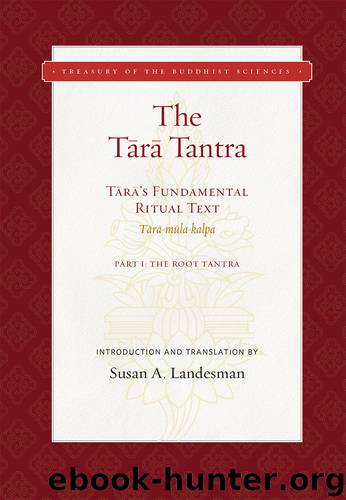The Tara Tantra by Susan A. Landesman

Author:Susan A. Landesman
Language: eng
Format: epub
Publisher: Wisdom Publications
Chapter B.3: The Third Extensive Ritual of the Middling Painted Cloth
After that, having beheld the entire retinue, Blessed Śākyamuni spoke to the Bodhisattva Great Being Avalokiteśvara, “O Great Being, furthermore, you have a middling ritual of the painted cloth. I shall explain it. Please listen thoroughly and comprehend it well as I explain.”
First of all, one should depict the subsequent painted cloth exactly as the first, except for its shape and measurement.696 One should use the spun threads formerly indicated, the same ritual previously expressed with the craftsman who was formerly chosen, and the very pure cotton cloth of the same medium dimensions — which is smooth, well-washed, fringed, purely colored, and free from hair, etc.
First, [depict] an extremely beautiful place in Śuddhāvāsa,697 made of crystal and jewels, and decorated with white pearl necklaces. At its center, depict Bhagavān Śākyamuni, seated on a jeweled-lion throne, appearing as if explaining the Dharma, and possessing the most excellent of all aspects (ākāra).
On his right side is Noble Avalokiteśvara, brilliant in color as a lotus filament, saffron, or sunlight. He holds a lotus beside his left shoulder, has his hands joined, and appears as if beholding the Bhagavān Śākyamuni. His face has a faint smile. The great Bodhisattva possesses an auspicious central uṣṇīṣa698 and a white sacred thread. His head is bowed and his right knee is bent.
To Bhagavān Śākyamuni’s left side, depict Vajrapāṇi, green as the priyaṅgu plant699 and exactly as formerly explained. Moreover, he is fanning the Bhagavān.
On this [same left] side, one should successively depict the following: Noble Maitreya, Samantabhadra, Vajrapāṇi,700 Mahāmatī, Śāntimatī, Gaganagañja, and Sarvanīvaraṇa-viṣkambhin. One should depict them in the same manner as in the first [extensive ritual of the superior painted image], decorated with all ornaments.
Above them, one should depict the eight Buddha Lords. They are to be seated and their right hands [display] the “have-no-fear” hand gesture (abhaya-mudrā). They wear an upper garment of pale yellow monk’s robes and a lower maroon-colored garment. Their left hands hold the fringe of these robes. They possess the best of all aspects and are entirely luminous. Here, one should depict the Buddha Bhagavāns called Tathāgata Saṅkusumitarāja, Ratnaśikhin, Viśvabhu, Krakucchanda,701 Kanakamuni, Kāśyāpa Buddha, and Sunetra.
On the Bhagavān’s right side, near Noble Avalokiteśvara, one should depict the great circle of retinue. One should depict the eight great Śrāvakas and the eight Pratyekabuddhas exactly as formerly explained. Moreover, one should draw Noble Mahāmaugalyāyana and Śāriputra sitting while fanning the Buddha Bhagavān. In the same way, one should depict the Sons of the Gods (devaputras) of the Śuddhāvāsakāyika heaven. One should also depict the Sons of the Gods of the heavens of Śakra Lord of the [Vedic] Gods, Suyāma (free from conflict), Tuṣita (Buddhist paradise of Maitreya), Nirmāṇaratiḥ (Pleasure of Miracles), Śuddha (Pure), Vimala (Stainless), Sudṛśa (Auspicious Sight), Ābhāsvara (Clear Light), Brahmā Sahāṃpati (Lord of the Sahā realm), and Akaniṣṭha (None Higher, Akṣobhya’s heaven). In the same way, one should depict the rest of the Sons of the Gods of the form realm and the desire realm in succession.
Download
This site does not store any files on its server. We only index and link to content provided by other sites. Please contact the content providers to delete copyright contents if any and email us, we'll remove relevant links or contents immediately.
The Way of Zen by Alan W. Watts(5789)
Ego Is the Enemy by Ryan Holiday(3982)
The Art of Happiness by The Dalai Lama(3377)
The Book of Joy by Dalai Lama(3212)
Why Buddhism is True by Robert Wright(2819)
Shift into Freedom by Loch Kelly(2688)
Spark Joy by Marie Kondo(2671)
Happiness by Matthieu Ricard(2516)
A Monk's Guide to a Clean House and Mind by Shoukei Matsumoto(2400)
The Lost Art of Good Conversation by Sakyong Mipham(2124)
The Meaning of the Library by unknow(2064)
The Third Eye by T. Lobsang Rampa(1882)
The Unfettered Mind: Writings from a Zen Master to a Master Swordsman by Takuan Soho(1858)
Anthology by T J(1750)
Red Shambhala by Andrei Znamenski(1745)
The Diamond Cutter by Geshe Michael Roach(1668)
Thoughts Without A Thinker: Psychotherapy from a Buddhist Perspective by Epstein Mark(1589)
Advice Not Given by Mark Epstein(1519)
Twilight of Idols and Anti-Christ by Friedrich Nietzsche(1488)
